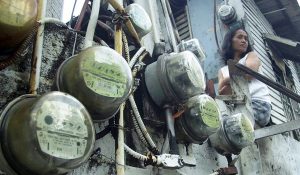MORE low-income electricity consumers could be admitted to the power subsidy program with the Energy Regulatory Commission (ERC) considering adjustments to the eligibility threshold for availing of “lifeline” rates.
In a statement on Wednesday, the ERC said it is conducting consultations on a proposed uniform national lifeline subsidy rate which will expand the coverage of the Lifeline Subsidy Program.
Under the proposal, qualified end-users consuming 50 kilowatt hours (kWh) per month or less will get a 100% discount on their electricity bills.
Qualified beneficiaries of the Pantawid Pamilyang Pilipino Program (4Ps) whose power consumption does not exceed the 50-kWh threshold will automatically be enrolled in the program and enjoy the lifeline rate.
According to Republic Act No. 9136 or the Electric Power Industry Reform Act, the ERC must offer subsidized electricity to qualified low-income consumers unable to pay their electricity bills at full cost.
At present, lifeline rate discounts vary depending on the prevailing rates of distribution utilities (DUs) or electric cooperatives.
Within the franchise area of Manila Electric Co. — the country’s largest private distribution utility — qualified lifeline consumers using 20 kWh per month or less are granted a 100% discount on generation, transmission, system loss, distribution, supply, metering, and other charges.
To fund the discounted rates under the enhanced program, a one-centavo per kWh lifeline subsidy rate will be collected. A lifeline subsidy fund will be created, which will be administered by state-run Power Sector Assets and Liabilities Management Corp. (PSALM).
DUs, retail electricity suppliers, and the National Grid Corp. of the Philippines will collect the subsidy rate and remit all proceeds to PSALM.
The ERC said it will conduct an annual review of the subsidy rate, consumption threshold, and sufficiency of the fund.
“We are conducting public consultation to gather valuable insights from all stakeholders. This participatory approach ensures that the proposed uniform national lifeline subsidy framework is not only aligned with the law, but is fair, transparent, and responsive to the needs of the marginalized electricity consumers,” ERC Chairman and Chief Executive Officer Francis Saturnino C. Juan said.
In a position paper dated Nov. 5, the National Association of Electricity Consumers for Reforms, Inc. (Nasecore) said the ERC should observe “equity and cost-of-service principles across all consumer classes,” instead of offering subsidies.
“Continuing to rely on the Lifeline Program to mask unfair pricing perpetuates dependence on cross-subsidies and hides inefficiencies, while punishing millions of non-lifeline households who dutifully pay but receive no protection,” Nasecore President Petronilo L. Ilagan said.
Gerry C. Arances, convenor of People for Power Coalition, said that the expansion of the program will only provide a “fraction of the relief needed by consumers as electricity costs soar.”
Since the program comes in the form of cross-subsidies, consumers are “pitted against each other while distribution utilities, especially those privately owned, continue to rake in billions,” he said.
“If the ERC and the Marcos administration are serious about solving the problem of energy poverty, they should have pushed through with the review of the Electric Power Industry Reform Act and its failed promise of least-cost electricity,” Mr. Arances said.
As of June 2025, around 4.5 million households have been identified by the Department of Social Welfare and Development as eligible for the Lifeline program, primarily through the 4Ps registry.
Only about 330,000 households or 7.34% of those qualified have registered with their respective DUs as of July, according to the Department of Energy. — Sheldeen Joy Talavera

